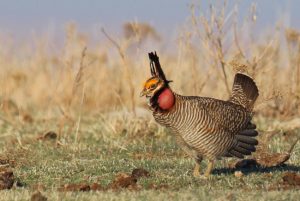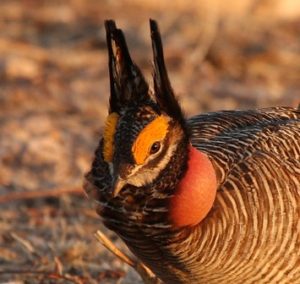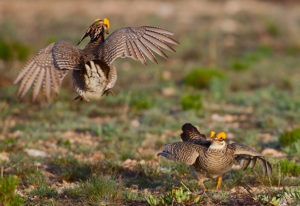A ‘Lek up’ for the Lesser Prairie Chicken in New Mexico!
As construction begins this week on its monumental Sagamore Wind Project in eastern New Mexico, wind developer, Xcel Energy, voluntarily buys mitigation credits in New Mexico’s first Lesser Prairie Chicken Conservation Bank, the result of a two-year effort by a host of partners including: Common Ground Capital, RiverBank Conservation, Tomahawk CB LLC, US Fish & Wildlife Service, Mack Kizer/Lost Draw Ranch, and the New Mexico Land Conservancy (NMLC).
It takes a collaboration to create a conservation bank
NMLC worked with a host of partners for nearly two years to complete its first US Fish & Wildlife Service (USFWS)─sanctioned Lesser Prairie Chicken conservation bank this fall near Milnesand, NM. A conservation bank is a mitigation tool designed to offset the potential impacts caused by a development or resource extraction activity in one area of the state by permanently protecting similar resources, such as LPC habitat, in another area.
A member of the grouse family, the Lesser Prairie Chicken (LPC) is known for its elaborate mating dance performed in communal areas called leks within its preferred grassland habitat. The iconic bird has become a kind of symbol for many New Mexicans of vanishing grasslands and a species losing ground to oncoming development.
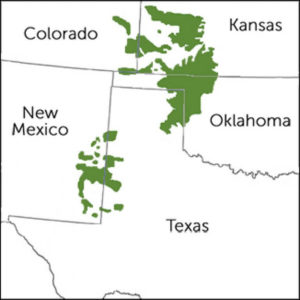
Current estimates are that only 38,000 “chickens” remain within a five-state range including portions of Kansas, Oklahoma, Colorado, Texas and a small and shrinking portion of eastern New Mexico – habitat that also coincides with the prime wind corridor blowing through our state from the northeast to southwest. [range map courtesy of American Bird Conservancy]
LPC populations have historically experienced boom-bust cycles, but by 2016, for several reasons, their populations dipped below their ability to recover in healthy numbers. The birds were listed as a federally “threatened” species under the Endangered Species Act (ESA) at that time, but later de-listed in 2018. Some experts speculate that the bird could be relisted again in the next few years.
Fragmentation of rangelands is of particular concern, which has caused individual LPC communities to become isolated, which causes inbreeding and leaves them vulnerable to factors such as heat waves or a severe drought, from which their populations cannot recover.
In addition to the impact from new roads and other land disturbances, wind energy development can also be problematic for the birds because they demonstrate a strong aversion to vertical structures, including wind turbines, and won’t nest near anything that researchers believe represents a tree or anything that might attract perching raptors.
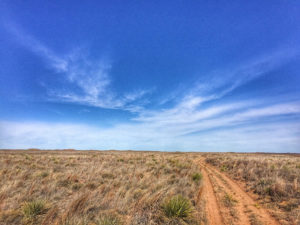
Big skies and open grasslands on the
Lost Draw Ranch owner, Mack Kizer, will be implementing short and long-term management plans that will improve the grasslands for the birds. Revenue from the Xcel purchase will also fund restoration projects on the bank to further support LPC populations onsite.
Conscientious Collaborators
As renewable energy becomes an inevitable reality, conscientious wind companies are looking for ways now to voluntarily mitigate the impacts of their development. Following a successful LPC conservation bank project in Texas, Adam Riggsbee, founder of RiverBank Conservation in Austin, TX, reached out to NMLC’s executive director, Scott Wilber, in 2017 to explore a potential collaboration to establish a similar bank in southeast New Mexico where a number of large wind farms are coming on line.
To start the project, Adam had to find a property of at least 9,000 acres suitable for LPC habitat, and a landowner willing to “sell” his future development rights through a conservation easement(s) on that property. After looking at land ownerships in the area around Milnesand south of Portales, he identified the Lost Draw Ranch which seemed to fit the necessary criteria. The ranch comprises approximately 10,500 acres in a remote part of southeastern New Mexico, the heart of LPC territory, owned by Mack Kizer, a long-time cattle rancher with an appreciation for wildlife.
Next, Adam turned to the USFWS to determine, from a wildlife perspective, whether or not to qualify the ranch as an official conservation bank for the LPC. RiverBank organized the biological assessment work – conducted the bird surveys, wrote the land management plan, produced the mapping and wrote the initial conservation bank proposal for the USFWS. The birds are elusive, often easier to hear than to locate visually, making population counts and study more challenging. This phase took over a year to complete.
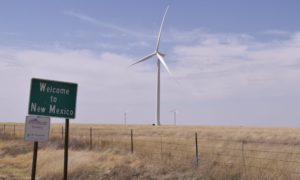
Lesser Prairie Chickens demonstrate a strong aversion to vertical structures, including wind turbines, and won’t nest near anything that researchers believe represents a tree or anything that might attract perching raptors.
Meanwhile, a conservation bank needs a financial sponsor and Adam turned to investment advisor, Wayne Walker, principal of Common Ground Capital based out of Oklahoma, with whom he had worked on other mitigation projects. Aware of the large Sagamore wind energy project coming on line, Wayne approached Xcel Energy to explore their potential interest in purchasing credits issued by the USFWS from the proposed conservation bank to fund the purchase of a conservation easement(s) from the landowner and the implementation of a series of management activities to improve LPC habitat on the ranch. Because the “chicken” was de-listed in 2016, the purchase of the credits was completely voluntary on the part of Xcel Energy, and intended to help offset the impact on LPC habitat from the development of its Sagamore wind project nearby.
Lastly, a conservation bank needs a land trust to develop and then hold the conservation easement(s) in perpetuity, as long as the conservation bank continues to meet the USFWS’s land management requirements for viable habitat for LPC and other wildlife species of interest and concern.
For the Birds
Mack Kizer’s Lost Draw Ranch in Roosevelt County was ideal for a “chicken” conservation bank. It’s big enough to meet the USFWS’s minimum size requirement of 9,000 acres. It contains prime LPC habitat in an area near wind development. And, it’s situated near other,existing LPC-protected habitat areas. “That was a key consideration,” Adam explains. The more contiguous protected parcels you can put together, the more effective the habitat landscape becomes [see map below].
The Lost Draw is directly adjacent to the 15,000-acre Weaver Ranch owned by ornithologist and former Cornell researcher, Jim Weaver, who is working voluntarily with the USFWS for the conservation of sensitive species through their Partners for Fish and Wildlife program on his property. The LPC-protected habitat on the Milnesand Prairie Preserve (MPP), owned by The Nature Conservancy (TNC) and the NM Department of Game & Fish (NMGF) LPC management areas are also near the Lost Draw Ranch, with additional significant NRCS-designated grasslands located close by.
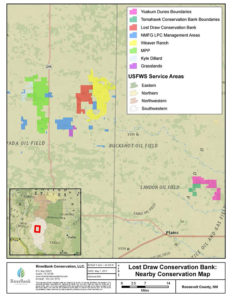
Most of the bank parcel consists of native intact prairie that is currently being grazed by cattle. In conjunction with RiverBank, Mack Kizer will be implementing short and long-term management plans that will improve the grasslands for the birds. Revenue from the Xcel purchase will also fund restoration projects on the bank to further support LPC populations onsite.
Adam Riggsbee can’t say enough good things about working with Mack Kizer, “. . . for hearing me out and giving me a chance,” Adam says. “Most people thought I was crazy when I said to them, ‘I want to pay you more than your land will ever be worth to protect this bird, if you will simply agree to some land management and restoration work on your property.’ Mack was very friendly and easy to work with, and he is excited to be contributing to the protection of these birds.”
The bank’s sponsor, Tomahawk CB, LLC, was organized by Wayne Walker. After years of observing what he calls “less than optimal solutions” to address conflicts in the energy and environment interface that typically shortchanged wildlife conservation, Wayne formed Common Ground Capital to establish common ground for key stakeholders by creating a financial product that properly values ecosystems services under an approved regulatory framework based on free market economics, and provides for commercially reasonable mitigation solutions to responsible energy developers
Xcel Energy is considered one of the “greener” utilities with a goal to be carbon free itself by 2030. By purchasing the conservation bank credits voluntarily, “they want to set a precedent for other wind companies developing in New Mexico and other western states,” Adam explained. The company’s Sagamore Wind Project, a 522-megawatt wind farm project currently under construction in Roosevelt County, near Portales, NM, is expected to become New Mexico’s largest wind farm and represents nearly $1 billion of private investment in southeastern New Mexico.
Because the LPC is not currently listed under the ESA and the credits were purchased voluntarily, the wind developer can’t pass on the cost of this mitigation to the public through regulated rate increases, nor will these credits apply directly to future mitigation efforts if or when the chicken is relisted. Wind developers hope, however, that undertaking voluntary mitigation efforts now may help offset the need to relist the bird in the future.
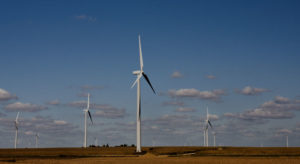
Xcel Energy broke ground this week (Monday, Dec. 16, 2019) on its Sagamore Wind Project —
a 522-megawatt wind farm across 100,000 acres in Roosevelt County.
The nearly $1 billion project is expected to be in operation by the second half of 2020.
NMLC is excited to be partnering with Common Ground Capital, RiverBank and USFWS on the Lost Draw Conservation Bank. More wind energy and other forms of renewable energy will be coming on line in New Mexico at increasingly larger scales, particularly with the recent passage of the Energy Transition Act and Governor Michelle Lujan-Grisham’s stated goal of making New Mexico’s energy sector carbon-free by 2045.
“However, like all large-scale energy projects, these wind projects are not without impacts on critical habitat for grassland birds, raptors, bats and other species of dependent wildlife,” noted Scott Wilber, NMLC’s Executive Director. “The Lost Draw Conservation Bank offers a promising free-market solution to helping conserve a highly threatened and vulnerable species – the Lesser Prairie Chicken – and potentially represents a replicable model that can be applied in other situations to conserve this and other threatened and endangered species, and potentially prevent them from being listed, which creates economic impacts for both the energy companies and the state.” #
